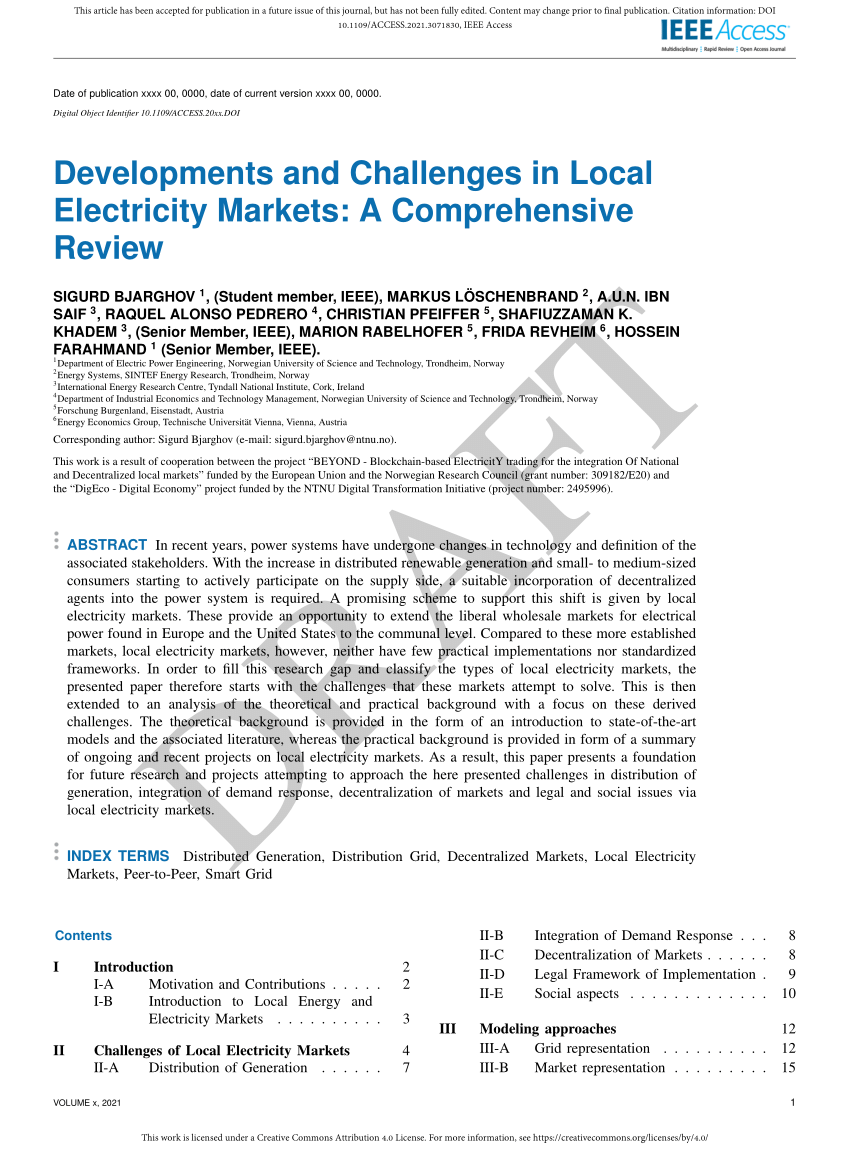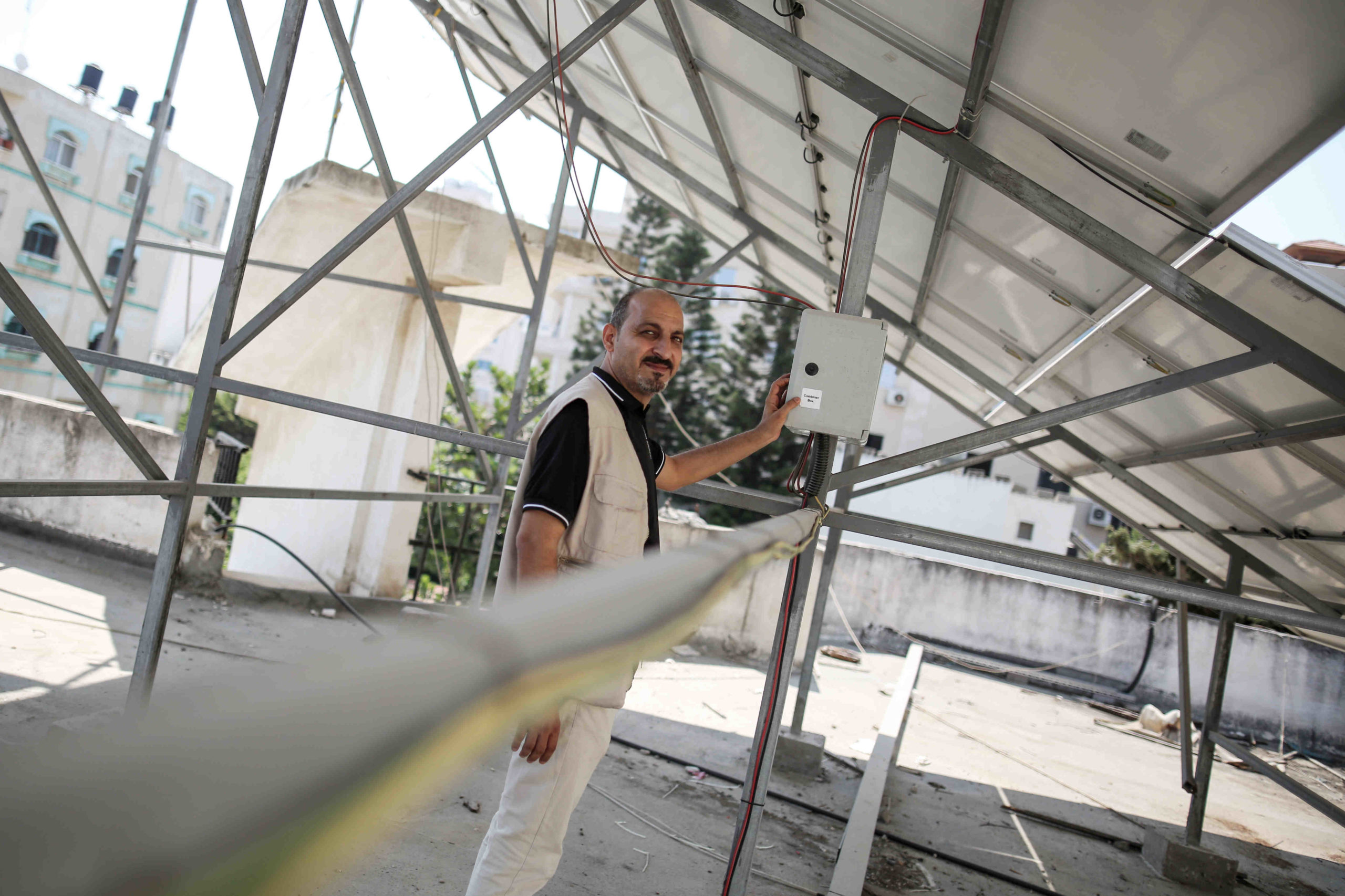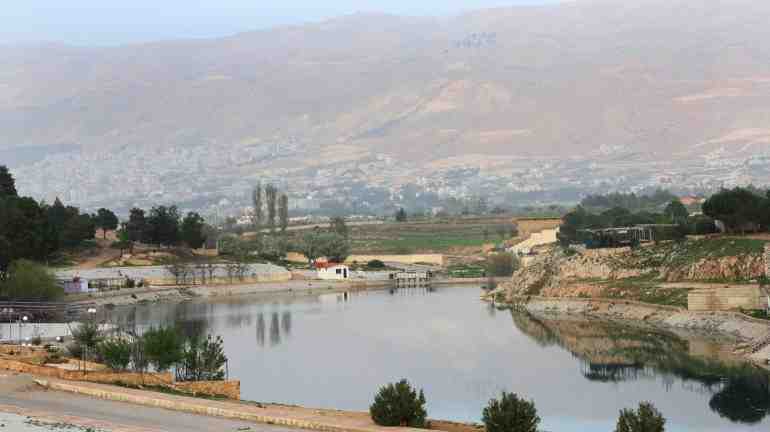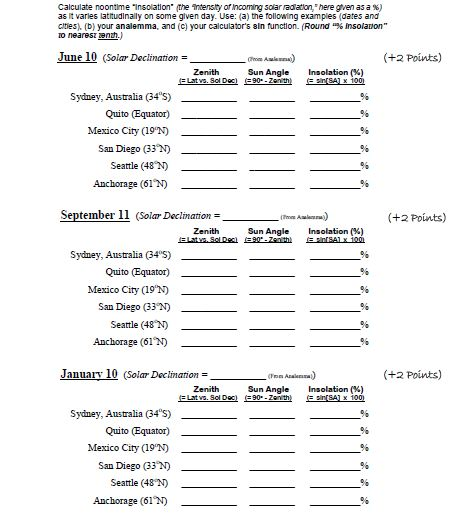To keep the lights on and the machines running at the only blood bank in the Gaza Strip, the Palestinians use the only natural resource they have in abundance: sunlight.
The vitality of this energy source became apparent earlier this month when the power plant in the teeming area was shut down by the most recent exchange of rockets and rocket attacks between Israel and Islamic Jihad in northern Gaza.
But the Central Blood Bank Association, whose roof is covered with solar panels, continued to operate despite the bombing that caused widespread power cuts in the rest of Gaza.
“Our project has helped them and this escalation was a first test,” Sami Matar told NBC News via Zoom from the Gaza Strip.
Matar, who is working with the American nonprofit American Near East Refugee Aid, or Anera, on solar projects throughout Gaza, said the installation of the solar energy system helped the blood bank run longer during working hours. He said the generator is often the second alternative when the standard power supply through the fuel plant fails. The entire project cost $46,000 and the panels are estimated to last about 20 years.
Next week, Matar said Anera plans to begin bidding for a construction company to install solar panels to power a reverse osmosis unit for an agricultural water source that will serve at least seven farms in Rafah. The goal is to remove salt from the water and help them grow more crops. It is expected to be ready by the end of September.
Earlier this month, a round of violence erupted in Gaza, killing 46 Palestinians, including 15 children and four women. In addition, 360 Palestinians and 70 Israelis were injured in the fighting.
During the attacks, the power plant in Gaza was shut down, causing power outages for more than 20 hours a day. Only after a ceasefire was declared on August 7 did the Israelis resume fuel deliveries through the Kerem Shalom border crossing to allow the plant to resume power generation.
“During an emergency, health facilities in Gaza have to work for more than 18 hours,” Matar said. And the blood bank works to meet the needs of hospitals and patients in the region.
Basma Abu Hattab, who worked as a supervisor on the installation of solar panels for the blood blank, said the solar panels will add at least 10 hours more capacity, but still advised the blood bank to keep a generator on standby.
“In the escalation, we have a special case because the power outage lasts 16 hours,” Abu Hattab said.
dr. Mostafa Al-Ghosain is also part of the Anera team working to resolve this issue. He said Anera is meeting an urgent need for medical supplies in 26 clinics and hospitals.
Recently, Anera provided about $70,000 in blood bag donations to the blood bank that arrived before the final battles with Israel, Al-Ghosain said.
Mohamed Thabet, a spokesman for the Gaza Electricity Distribution Company, said Palestinians have six hours of electricity, followed by 12 hours without electricity since the last violence. It used to be eight hours of electricity, followed by eight hours without electricity.
“We are trying to manage all the energy we have in Gaza, and we need renewable energy in Gaza to reduce the deficit,” Thabet told NBC News via Zoom from the Gaza Strip.
Electricity to the Gaza Strip usually comes from three sources, including 120 megawatts from the Israeli electric utility, 60 megawatts from the fuel-dependent power plant in Gaza and 30 megawatts from Egypt, but lines from the Egyptian side have been disconnected since February 2018. said Thabet.
Gaza needs between 500 and 600 megawatts each day, depending on the weather, Thabet said. It receives less than 40% of its required energy.
Khaled Elgindy, senior fellow and program director of the Middle East Institute, said the fuel shortages, blockades and frequent strikes with Israel are all affecting how Gaza’s power plant functions and the amount of electricity people receive.
In an area where there’s a lot more sunlight that can be used for energy, Elgindy said sunlight alone isn’t enough.
“Theoretically, the sun is an unlimited resource, but of course you need the infrastructure,” Elgindy said. “You need solar panels.”
The US State Department’s Office of Palestine Affairs said this summer that renewable sources such as solar energy “would also improve Palestinians’ access to energy and serve environmental goals.”
Investment in solar panels is not new in the occupied Palestinian territories, but organizations like Anera are helping the Palestinian territory access alternative energy sources and are using donations to meet that demand.
The World Bank announced a $23.5 million grant earlier this year to invest in alternative energy sources such as solar to promote sustainability in the Palestinian energy sector.
“Obviously it can’t be used as a base tax in a sense because you don’t generate electricity at night,” said Kanthan Shankar, World Bank country director for the West Bank and Gaza. “It’s in addition to existing electricity needs, but what happens is your costs go down as you can use more solar energy, especially in a situation where fuel costs continue to rise and it’s intermittent.”
Consent and approval for materials such as solar panels and batteries must come from Israel before they can enter Gaza, leading to long waiting times — as much as a year in some cases, Matar said.
However, political instability will continue to hinder a long-term solution to the energy problems of the West Bank and Gaza, Elgindy said.
“As long as Gaza is separated from the West Bank, as long as the Palestinian leadership is divided, as long as the occupation and blockade continue, the Palestinians’ ability to function normally will be severely hampered,” he said.
In addition to establishing the solar blood bank, Anera has helped bring solar energy to schools and other facilities in Gaza and the West Bank and parts of Lebanon. It hopes to raise more funds in the future to run more solar projects and target additional health centers and educational institutions.
“Insha’Allah I hope to see that all the daily challenges we have will end soon, especially the power outage, the water problem, and to live normally like other people in the world,” Matar said with a smile. “This is the basis of life, just like electricity. It is a major challenge for the people of Gaza.”
Rima Abdelkader is a senior reporter for Social Newsgathering at NBC News in New York.
As previously mentioned, Israel controls all entry into and out of the Gaza Strip and uses that control to limit supplies, humanitarian aid and even electricity going into Gaza. This has led to an energy crisis in Gaza, where 2 million Palestinians live without reliable access to the resources they need.
How Israel is leading the future of energy?

Israel aims to get 30% of its energy needs from renewable sources by 2030. Israel aims to increase its solar power by more than double by 2025. This may interest you : Plastic solar cells combine high-speed optical communication with indoor energy harvesting. The government aims to produce 30% of Israel’s energy from renewable sources by the end and 70% from natural gas by the end of this decade.
How does Israel generate electricity? In 2018, 70% of electricity came from natural gas and 4% from renewable energy sources, 95% of which was solar PV. In 2020, the government has committed that the amount of renewable energy sources should be 30% by 2030.
Is Israel self sufficient in energy?
While Israel remains an oil-importing country, offshore natural gas discoveries are rapidly changing the Israeli energy sector. Read also : Ultralight flexible perovskite solar cells. Once completely dependent on oil and gas imports, Israel is now self-sufficient and an exporter of natural gas.
What is Israel’s main source of energy?
Electricity. Although coal has long been Israel’s main source of electricity, its use is declining as the country’s natural gas sector continues its rapid growth and natural gas-fired generation capacity is displacing coal-fired generation capacity.
Is Israel energy independent?
One of the achievements of 74-year-old Israel is to be independent in meeting its energy needs. In fact, we still use imported coal and oil to produce electricity, but if forced, Israel can quickly adapt to generate all the energy it needs from its own sources, mainly natural gas.
Does Israel have a large supply of natural gas?
Experts say Israel’s supplies, extracted from three offshore gas fields in the Mediterranean, will be nowhere near Russian capacity. Israel produces about 12 billion cubic meters of natural gas a year, although industry analysts say at least double that amount is in untapped reserves.
What is Israel’s main source of energy?
Electricity. Although coal has long been Israel’s main source of electricity, its use is declining as the country’s natural gas sector continues its rapid growth and natural gas-fired generation capacity is displacing coal-fired generation capacity.
Where does Israel get their gas and oil?
The Tamar field, estimated to have 318 BCM recoverable reserves, was discovered in 2009 and supplied more than 94% of Israel’s natural gas in 2018. Transport of natural gas from the Tamar field started in 2013.
Does Israel have a large supply of natural gas?
Experts say Israel’s supplies, extracted from three offshore gas fields in the Mediterranean, will be nowhere near Russian capacity. Israel produces about 12 billion cubic meters of natural gas a year, although industry analysts say at least double that amount is in untapped reserves.
Is Israel rich in oil and gas?
The country has negligible reserves of crude oil, but does have abundant inland natural gas resources that were discovered in large quantities as of 2009, after many decades of previously failed exploration.
Does Israel have a large supply of natural gas?
Experts say Israel’s supplies, extracted from three offshore gas fields in the Mediterranean, will be nowhere near Russian capacity. Israel produces about 12 billion cubic meters of natural gas a year, although industry analysts say at least double that amount is in untapped reserves.
Is Israel self sufficient in natural gas?
Natural gas: Once completely dependent on oil and gas imports, Israel is now self-sufficient and an exporter of natural gas. The first significant find was the Tamar gas field, discovered by the US company Noble Energy (recently acquired by Chevron) and its local partners.
What country has the largest natural gas supply?
| # | Country | Share the world |
|---|---|---|
| 1 | Russia | 24.3% |
| 2 | Iran | 17.3% |
| 3 | Qatar | 12.5% |
| 4 | United States | 5.3% |
Does Israel have lots of natural gas?
Gas reserves in Israel Israel holds 6.22 trillion cubic feet (Tcf) of proven gas reserves as of 2017, ranks 45th in the world and accounts for approximately 0.090% of the world’s total natural gas reserves of 6,923 Tcf. Israel has proven reserves equal to 17.6 times its annual consumption.
Who supplies Gaza with electricity?

The Israel Electric Corporation (IEC) provides most of the electricity in the Palestinian territories. PETL is the sole purchaser of imported electricity for distribution in Areas A and B of the West Bank and Gaza Strip, which in turn supplies the electricity to the six Palestinian distribution companies.
Who supplies water and electricity to Gaza? Gazans traditionally have their electricity supplies from three sources: just under two-thirds is imported from Israel, about 23 percent is domestically generated by the Gaza power plant, and the rest is imported from Egypt.
How much electricity does Israel give Gaza?
As a background, it’s worth pointing out that Gaza’s electricity supply comes from two sources: the first is Israel’s electric utility, which provides 120 MW of electricity to the Gaza Strip through ten lines; the second is the Gaza power plant, whose transformers and fuel tanks have been bombed several times…
Where does Gaza get its electricity?
Gaza’s electricity is normally supplied by its only diesel power plant, which is rated at 60-140 MW (figures vary depending on the degree of operation and damage to the plant) and which relies on raw diesel fuel, which is imported through Israel .
Why does Gaza have no electricity?
The current power crisis in Gaza dates back to 2006, when Israeli airstrikes destroyed all six transformers of Gaza’s only power plant. The power plant has only been partially rebuilt. An Israeli blockade prevents the parts, equipment and fuel needed for reconstruction from reaching Gaza.
Does Israel supply Gaza with electricity?
Power Sources Nearly all of Gaza’s liquid fuel and about half of its electricity is supplied by Israel. These deliveries are not normally subject to the ongoing blockade of the Gaza Strip, although restrictions are in place.
Does Israel control electricity in Gaza?
The Gaza Strip depends on Israel for most of its electricity supply, although there is one internal factory. The current aggression has resulted in residents receiving only three to four hours of electricity per day, with periods as long as 20 hours without any supply.
What does Israel control in Gaza?
Israel controls the northern borders of the Gaza Strip, as well as territorial waters and airspace. Egypt controls the southern border of the Gaza Strip, under an agreement between the country and Israel. Neither Israel nor Egypt allow free travel from Gaza, as both borders are heavily fortified militarily.
Does Israel provide electricity to Gaza?
Power Sources Nearly all of Gaza’s liquid fuel and about half of its electricity is supplied by Israel. These deliveries are not normally subject to the ongoing blockade of the Gaza Strip, although restrictions are in place.
Who controls power in Gaza?
| Hamas government in Gaza | |
|---|---|
| Overview | |
| State | Gaza Strip |
| Leader | Prime Minister of the Palestinian National Authority |
| Appointed by | Palestinian Legislative Council |
Who supplies power to Gaza?
Power Sources Electricity is normally provided by: Gaza’s only power plant rated 60-140 MW (figures vary depending on the degree of operation and damage to the plant) which relies on diesel fuel imported through Israel, 125 MW supplied by Israel Electric Corporation (IEC) through 10 power lines, and.
Who is supplying weapons to Gaza?
The main smuggling route is from Iran to Sudan, on to Egypt and the Sinai Peninsula, and from there to the Gaza Strip, with Iran directly involved in supplying the weapons and transferring them to the Gaza Strip.
Who controls power in Gaza?
| Hamas government in Gaza | |
|---|---|
| Overview | |
| State | Gaza Strip |
| Leader | Prime Minister of the Palestinian National Authority |
| Appointed by | Palestinian Legislative Council |
Where does Gaza get electricity from?
Gaza’s electricity is normally supplied by its only diesel power plant, which is rated at 60-140 MW (figures vary depending on the degree of operation and damage to the plant) and which relies on raw diesel fuel, which is imported through Israel .
Why does Gaza have no electricity?

The current power crisis in Gaza dates back to 2006, when Israeli airstrikes destroyed all six transformers of Gaza’s only power plant. The power plant has only been partially rebuilt. An Israeli blockade prevents the parts, equipment and fuel needed for reconstruction from reaching Gaza.
Is there electricity in Gaza? Gaza Electricity Crisis. Gaza’s electricity is normally supplied by Gaza’s only diesel power plant, which is rated at 60-140 MW (figures vary depending on the degree of operation and damage to the plant) and which relies on crude diesel fuel, which imported through Israel.
Does Israel supply electricity to Gaza?
Power Sources Nearly all of Gaza’s liquid fuel and about half of its electricity is supplied by Israel. These deliveries are not normally subject to the ongoing blockade of the Gaza Strip, although restrictions are in place.
How much electricity does Israel give Gaza?
As a background, it’s worth pointing out that Gaza’s electricity supply comes from two sources: the first is Israel’s electric utility, which provides 120 MW of electricity to the Gaza Strip through ten lines; the second is the Gaza power plant, whose transformers and fuel tanks have been bombed several times…
Where does Gaza get its electricity?
Gaza’s electricity is normally supplied by its only diesel power plant, which is rated at 60-140 MW (figures vary depending on the degree of operation and damage to the plant) and which relies on raw diesel fuel, which is imported through Israel .
Did Israel cut off electricity in Gaza?
Power in Gaza City, Palestine’s largest city, was cut as a result of Israeli attacks on the Gaza Strip, a source told Sputnik. Power in Gaza City, Palestine’s largest city, was cut as a result of Israeli attacks on the Gaza Strip, a source told Sputnik.
Do Palestinians have access to electricity?
Access to electricity, percent of the population The average value for Palestine in that period was 99.51 percent with a minimum of 97.9 percent in 1997 and a maximum of 100 percent in 2016. The latest value from 2020 is 100 percent. In comparison, the global average in 2020 based on 197 countries is 86.26 percent.
Where does Palestine get its energy?
The Palestinian territories mainly depend on Israeli imports to meet their electricity needs, representing 99 percent of the total supply in the West Bank and 64 percent of the total supply in Gaza.
Is there electricity in Palestine?
National sources produce only 445 GW/hour of electricity and supply less than 10% of the demand. The only domestic source of energy is the disputed Gaza Marine gas field, which has not yet been developed. Palestinian energy demand grew rapidly, growing at an annual rate of 6.4% between 1999 and 2005.
Do people in Gaza have electricity?
The Gaza Strip depends on Israel for most of its electricity supply, although there is one internal factory. The current aggression has resulted in residents receiving only three to four hours of electricity per day, with periods as long as 20 hours without any supply.
Where does Palestine get its energy?

The Palestinian territories mainly depend on Israeli imports to meet their electricity needs, representing 99 percent of the total supply in the West Bank and 64 percent of the total supply in Gaza.
Do Palestinians have access to electricity? Access to electricity, percent of the population The average value for Palestine in that period was 99.51 percent with a minimum of 97.9 percent in 1997 and a maximum of 100 percent in 2016. The latest value from 2020 is 100 percent. In comparison, the global average in 2020 based on 197 countries is 86.26 percent.
What is Palestine main source of income?
| Statistics | |
|---|---|
| Main industries | Cement, quarries, textiles, soap, olive carvings, mother-of-pearl souvenirs, food processing |
| Ease-of-doing-business ranking | 117th (average, 2020) |
| External | |
| export | $720 million (2011) |
How does Gaza make money?
Gaza City’s economy depended on small industries and agriculture. After years of decline, Gaza’s economic growth is now increasing, boosted by foreign aid. According to the International Monetary Fund, the economy grew by 20 percent in 2011, and gross domestic product per capita grew by 19 percent.
What does Palestine produce?
Palestine mainly exports cement, base metals, iron and steel, food and beverages, furniture, plastics and dairy products. Palestine’s main export partner is Israel (more than 80 percent of total exports).
Where does Palestine get electricity?
Electricity Imports The Israel Electric Corporation (IEC) supplies most of the electricity in the Palestinian territories.
Does Israel give electricity to Gaza?
Power Sources Nearly all of Gaza’s liquid fuel and about half of its electricity is supplied by Israel. These deliveries are not normally subject to the ongoing blockade of the Gaza Strip, although restrictions are in place.
Who holds power in Palestine?
Mahmoud Abbas (Abu Mazen), President of the Palestinian Authority since 2005 (disputed since 2009).
Does Palestine have oil and gas?
Geologists and commodity economists have confirmed that the Occupied Palestinian Territory (oPt) lies above sizable reservoirs of oil and natural gas wealth, in Area C of the West Bank and Mediterranean coast off the Gaza Strip, according to a recent UNCTAD study.
Is Palestine rich in resources?
Historically Palestine has long had an abundance of natural resources ranging from freshwater and groundwater, arable land and, more recently, oil and natural gas. In the seven decades since the establishment of the State of Israel, these resources have been compromised and exploited through a variety of measures.
How much oil does Palestine have?
A recent study by the United Nations Conference on Trade and Development (UNCTAD) finds that new discoveries of natural gas in the Levant Basin are on the order of 122 trillion cubic feet, while recoverable oil is estimated at 1.7 billion. barrels.
Is Palestine rich in oil and gas?
According to UNCTAD, the occupied Palestinian territory is “above sizable oil and natural gas deposits,” but “the occupation prevents Palestinians from developing their energy fields to exploit and benefit from such assets.” In 2012, the available electricity in the West Bank and Gaza was 5,370 GW-…

